Communicative English grammar teaching to high school learners in Vietnam
In Vietnamese high schools, English is mainly delivered in grammar translation method to ameliorate student achievement in grammar-Oriented examinations. In a long term, students suffer from fatigue and failure to communicate properly. This research aimed to apply the communicative approach in grammar teaching to improve students’ communicative competence and enhance their interest in grammar lessons. To obtain the above targets, a conceptual framework of studying grammar was shaped with the view that grammar should be studied in a context. The study employed reflective approach as the main research design and quantitative approach as a supplementary method. A teaching program with four trialed grammar lessons was implemented in TNH High School, Vietnam and data were collected from two instruments of observation and questionnaire. The findings showed that the students’ communicative competence and interest in the grammar lessons were significantly enhanced. The research outcomes were then translated into several recommendations to improve the quality of grammar teaching and learning at high schools in Vietnam
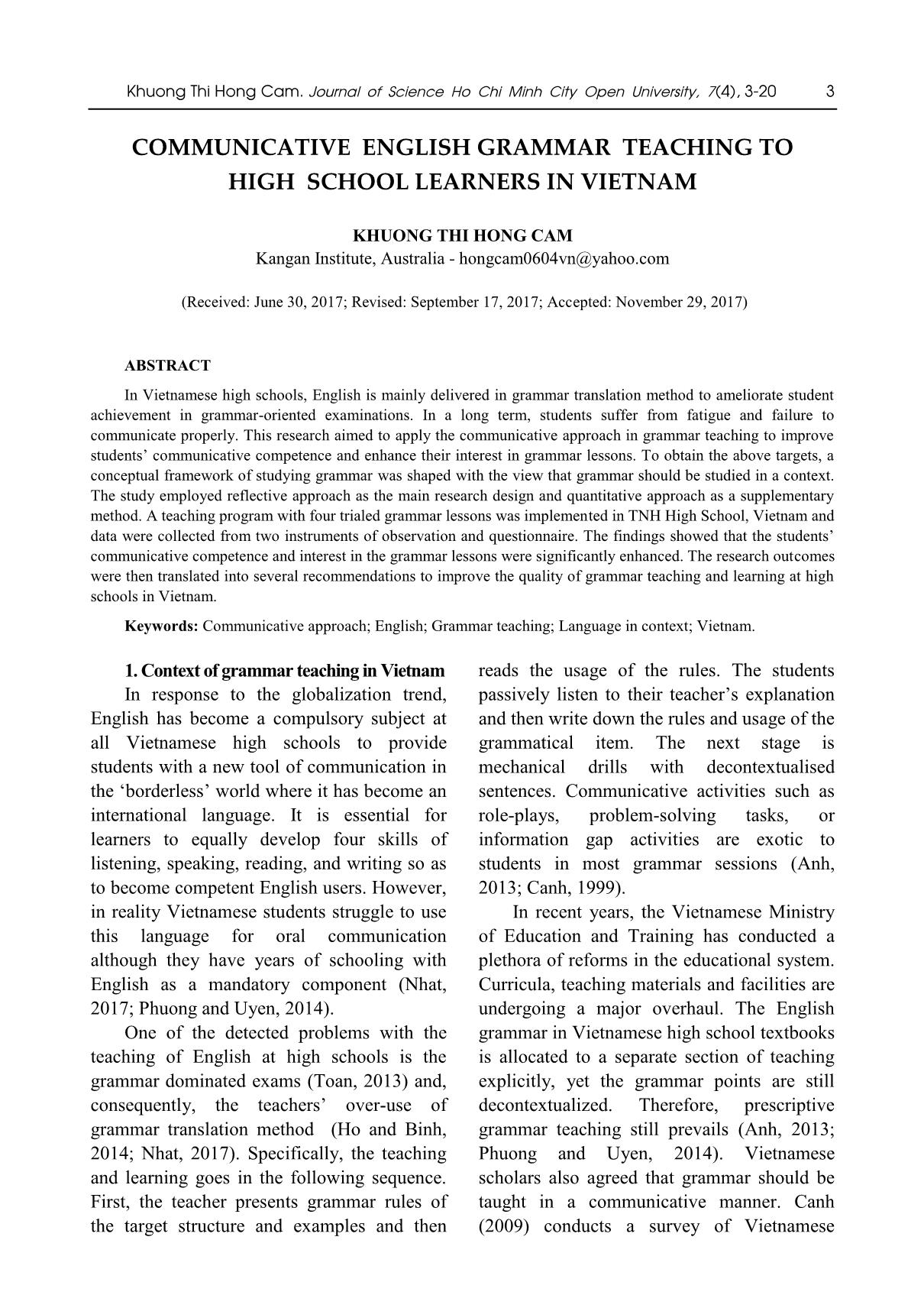
Trang 1
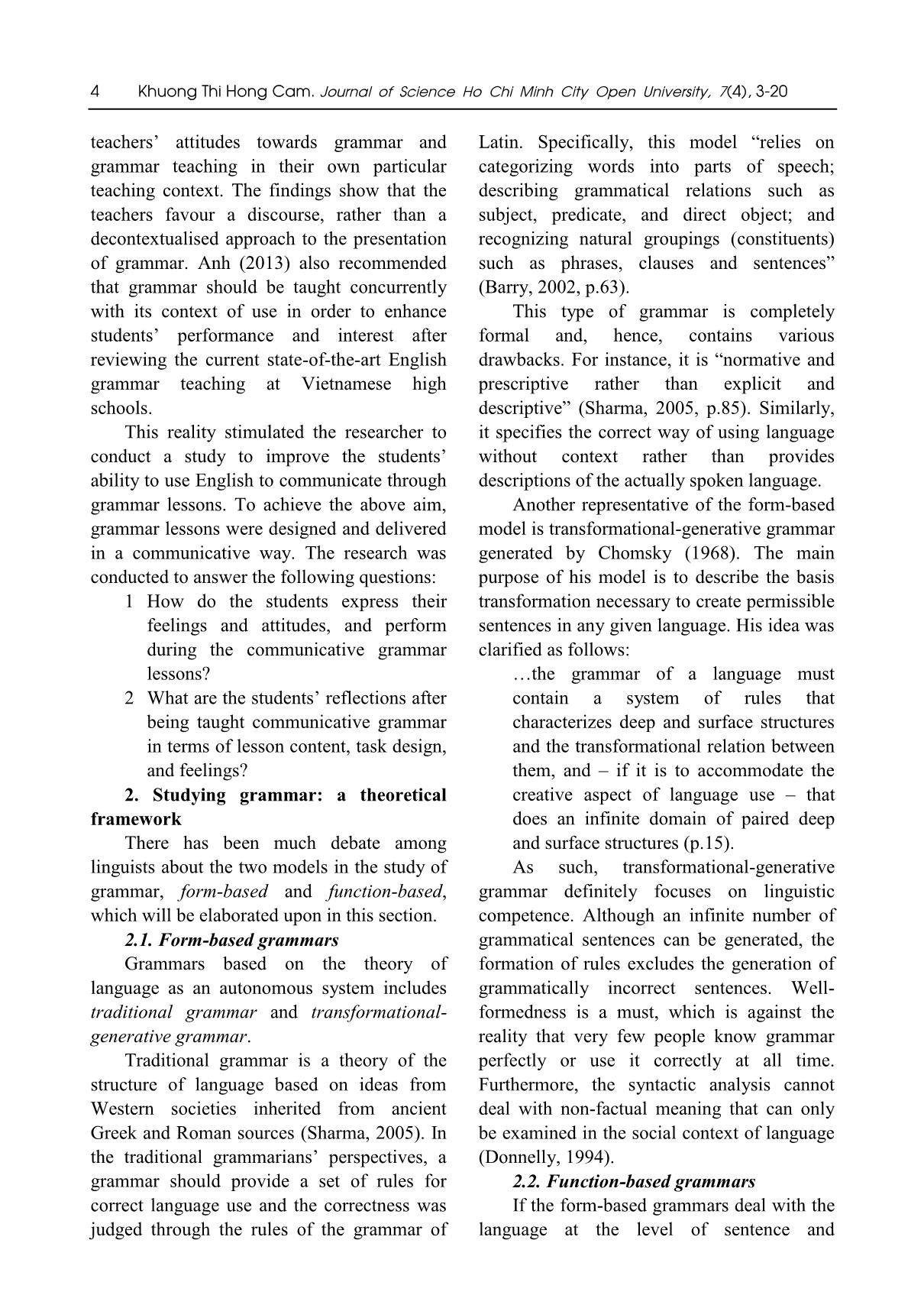
Trang 2
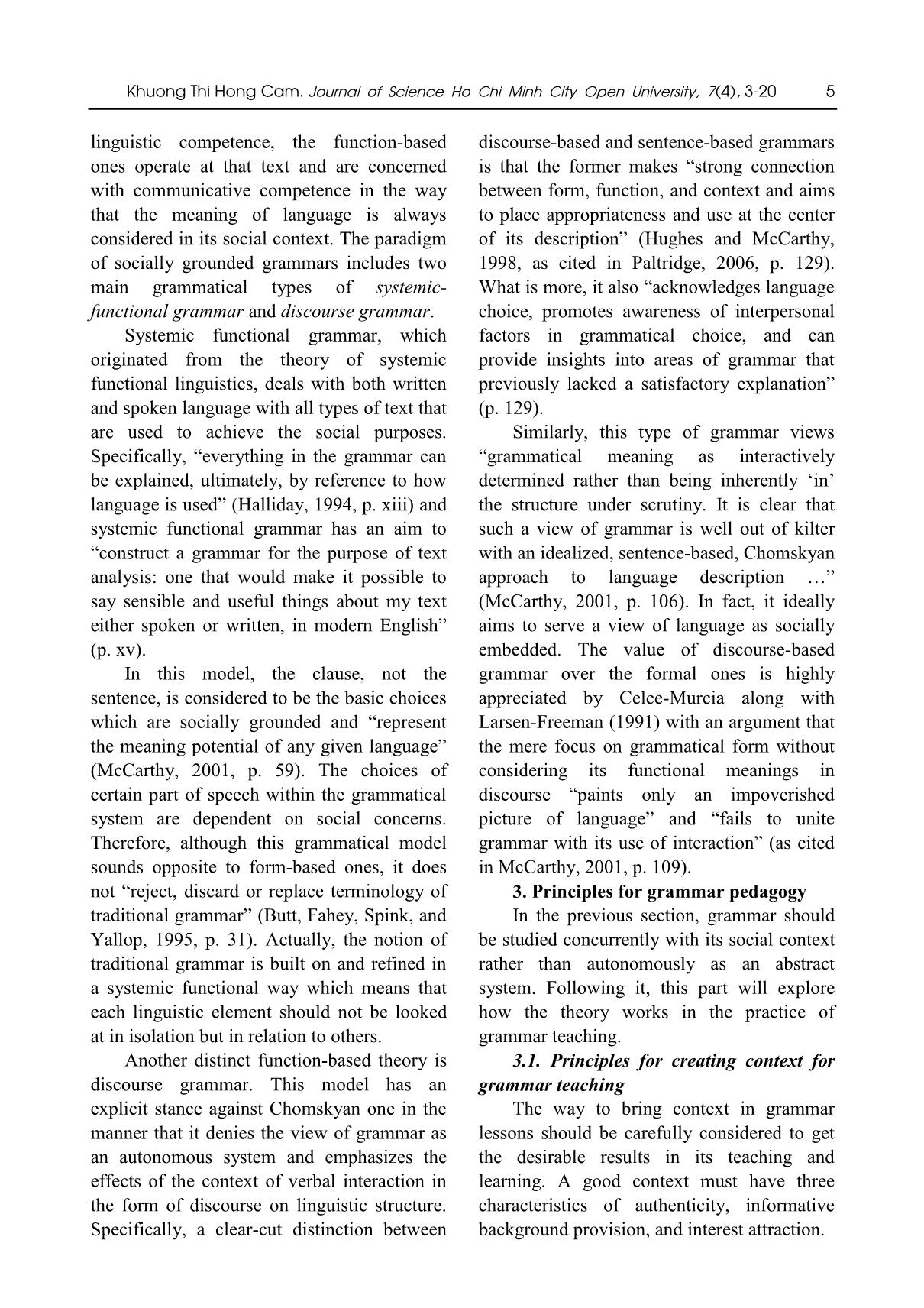
Trang 3
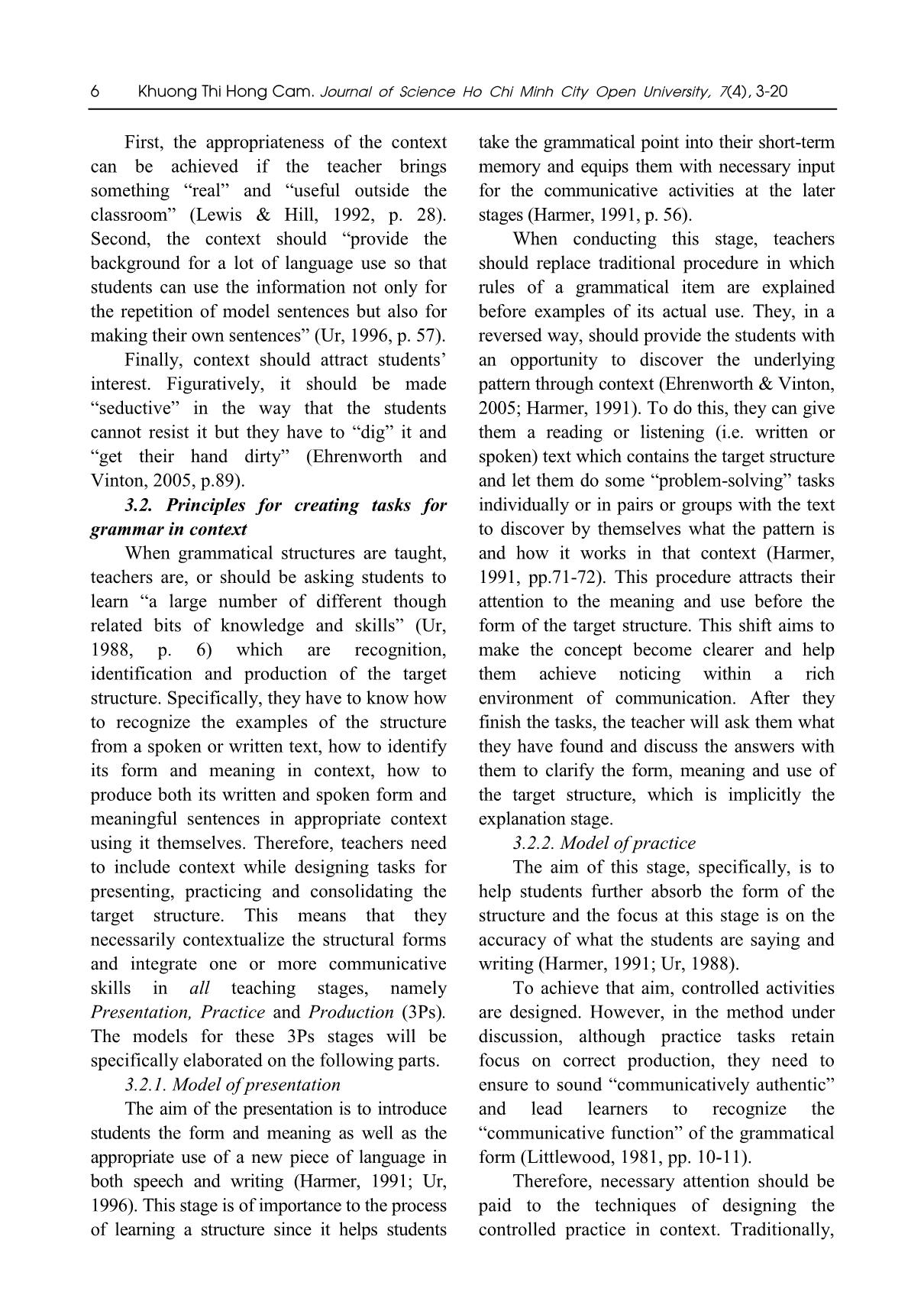
Trang 4
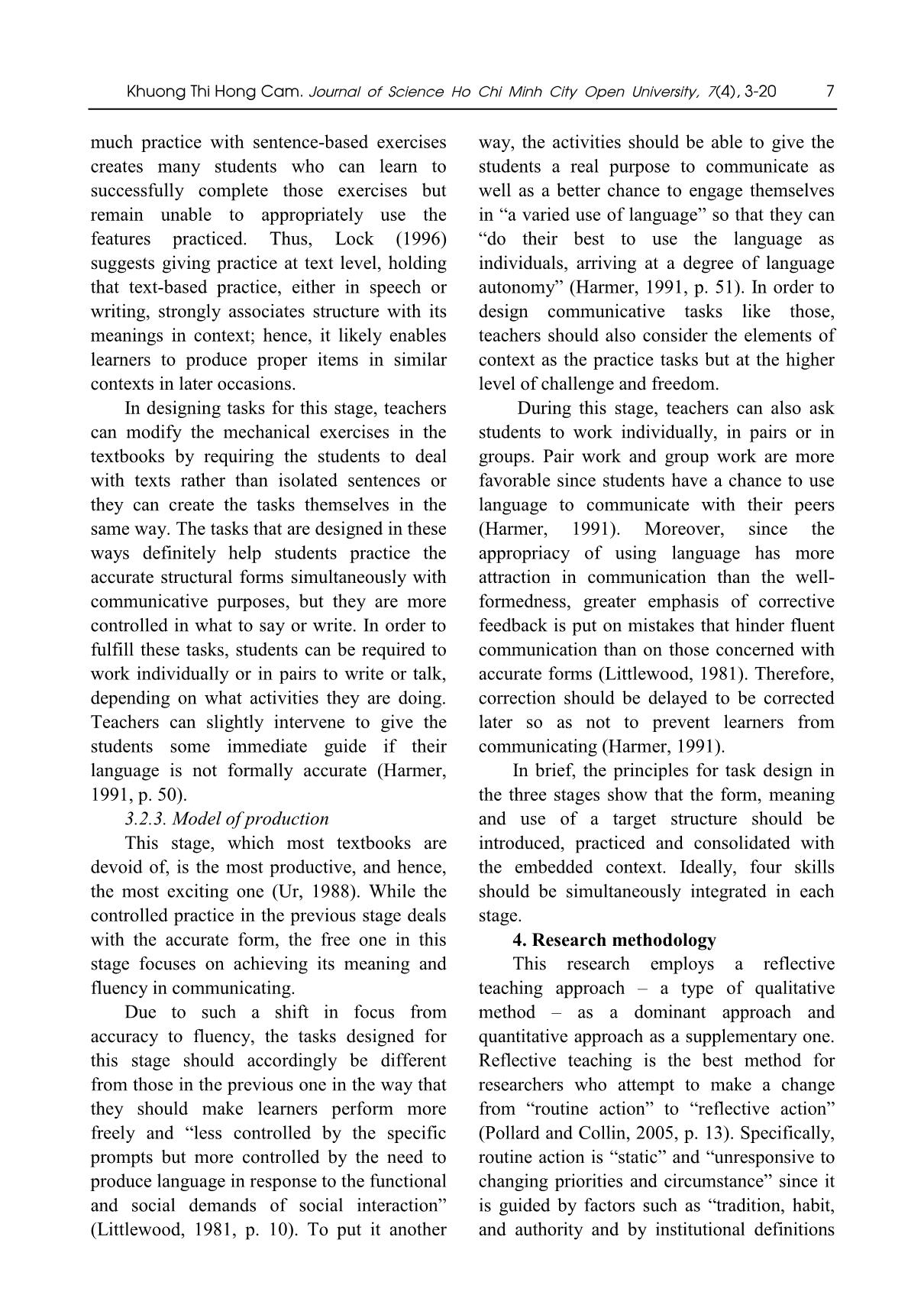
Trang 5
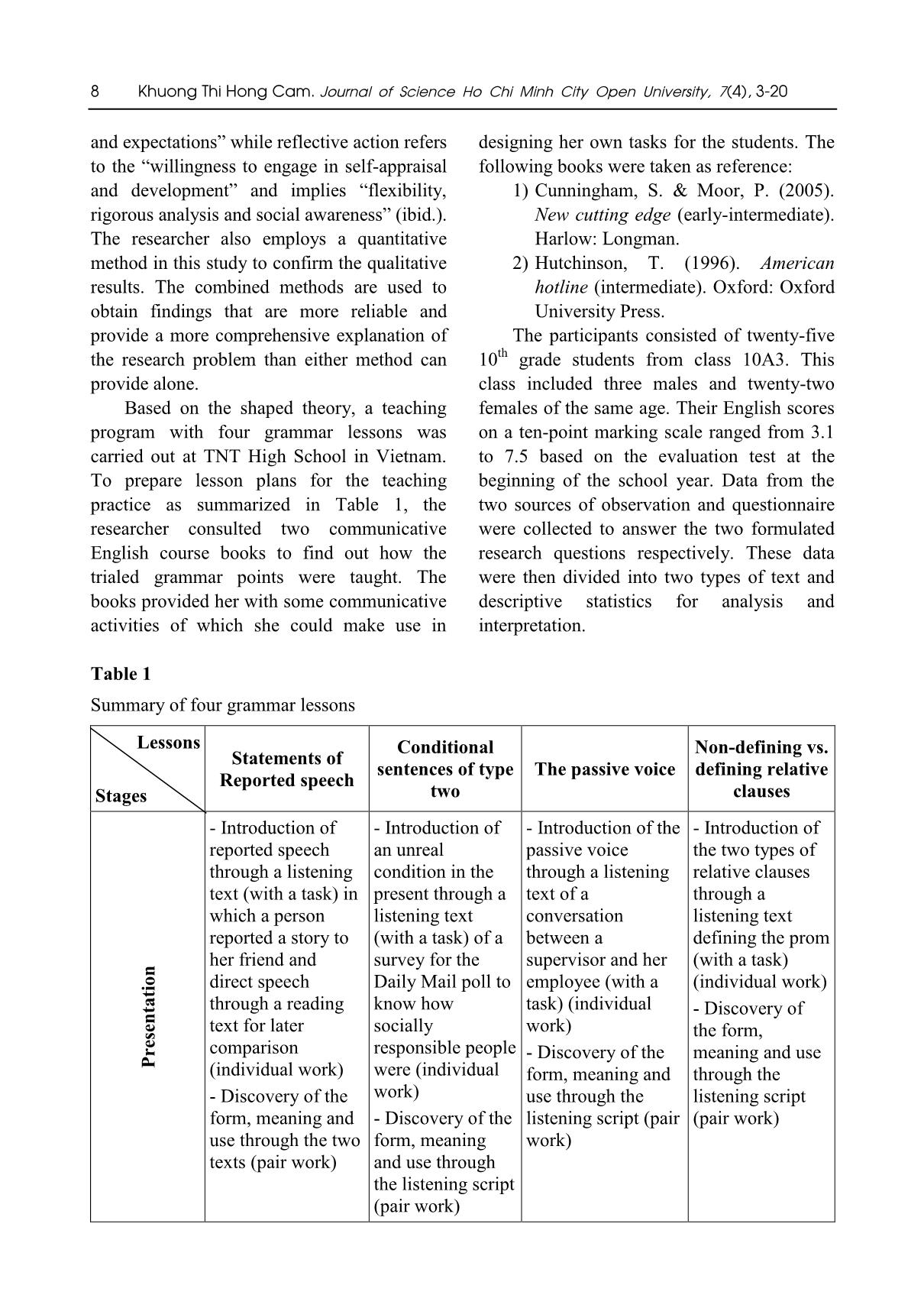
Trang 6
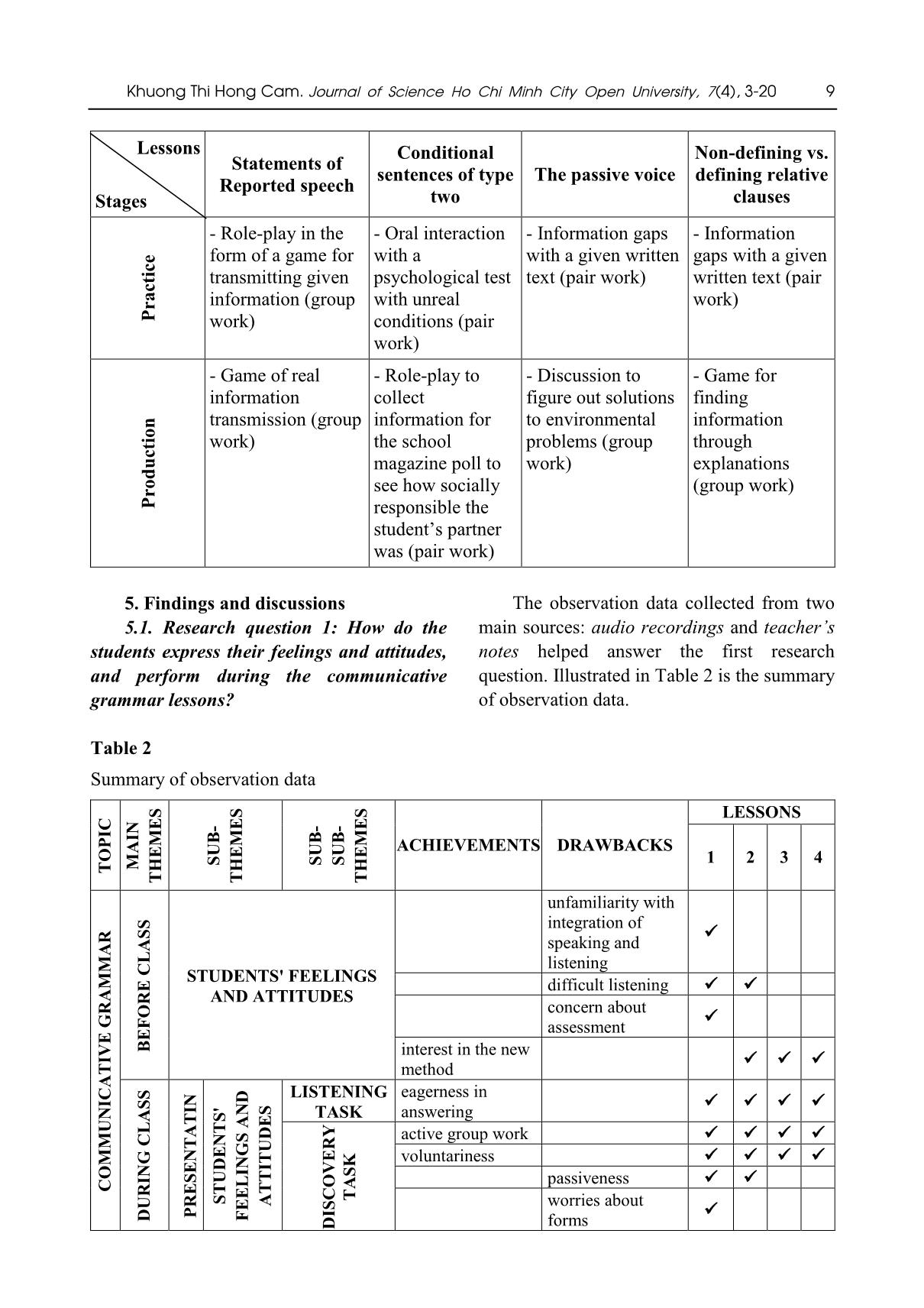
Trang 7
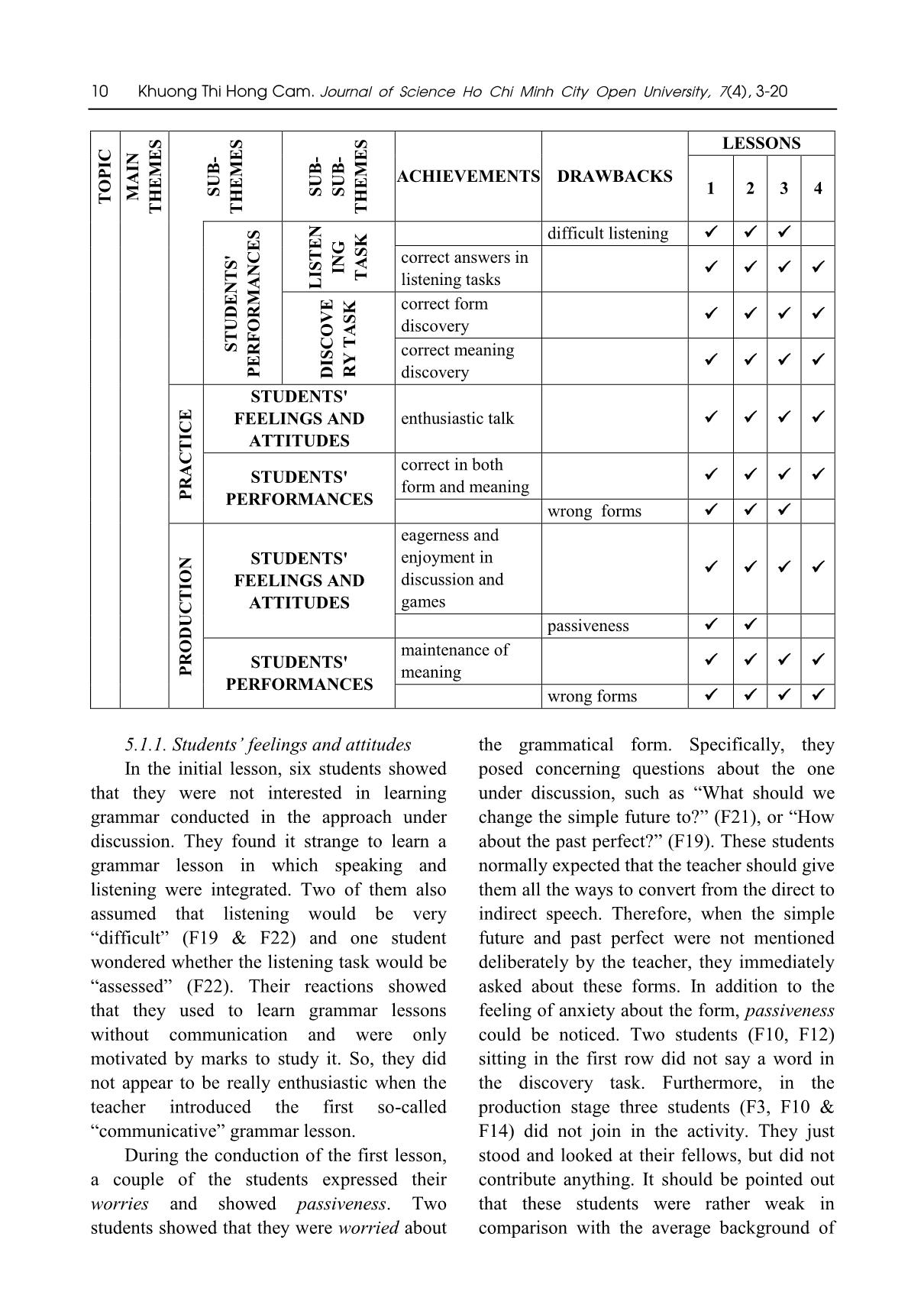
Trang 8
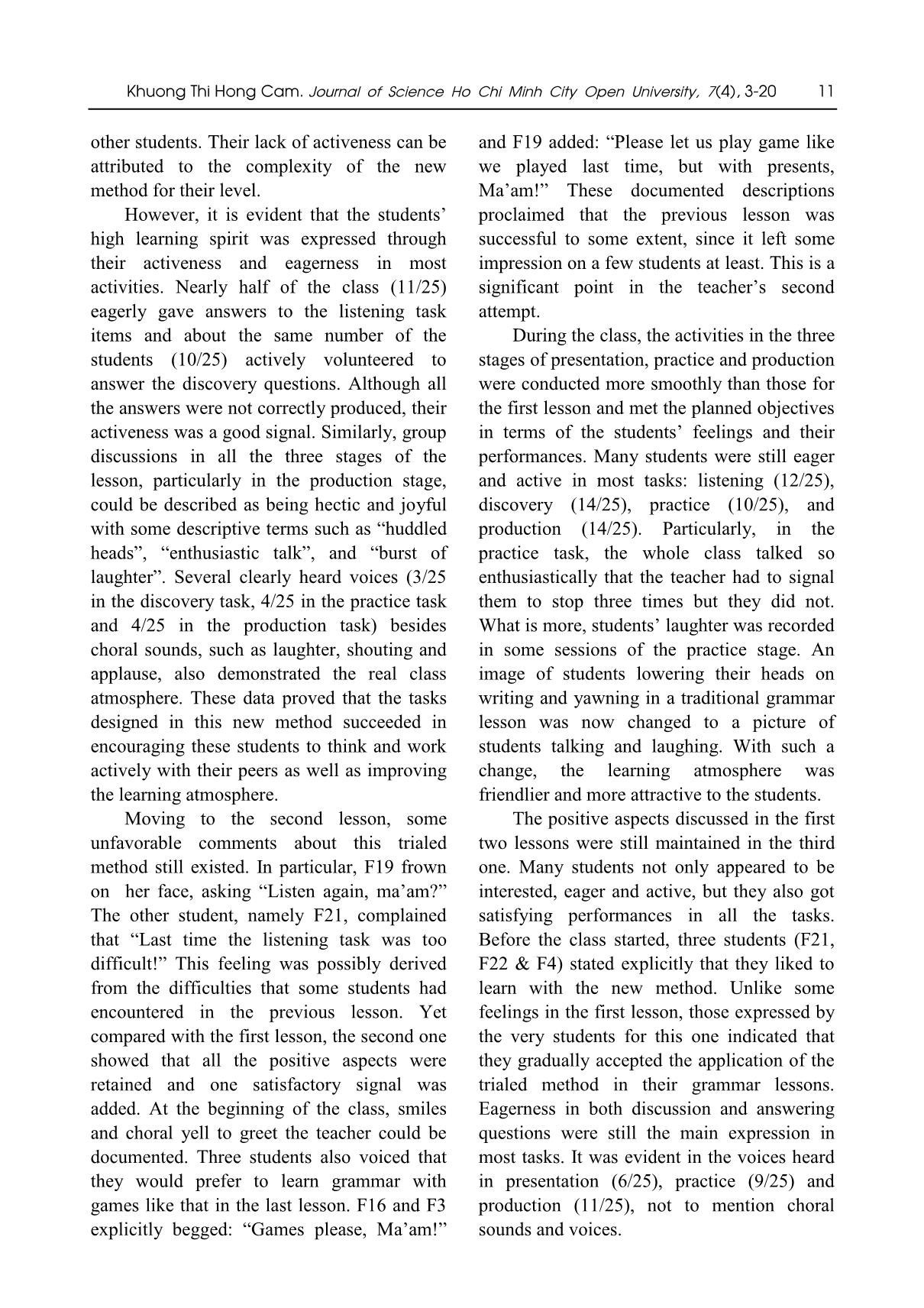
Trang 9
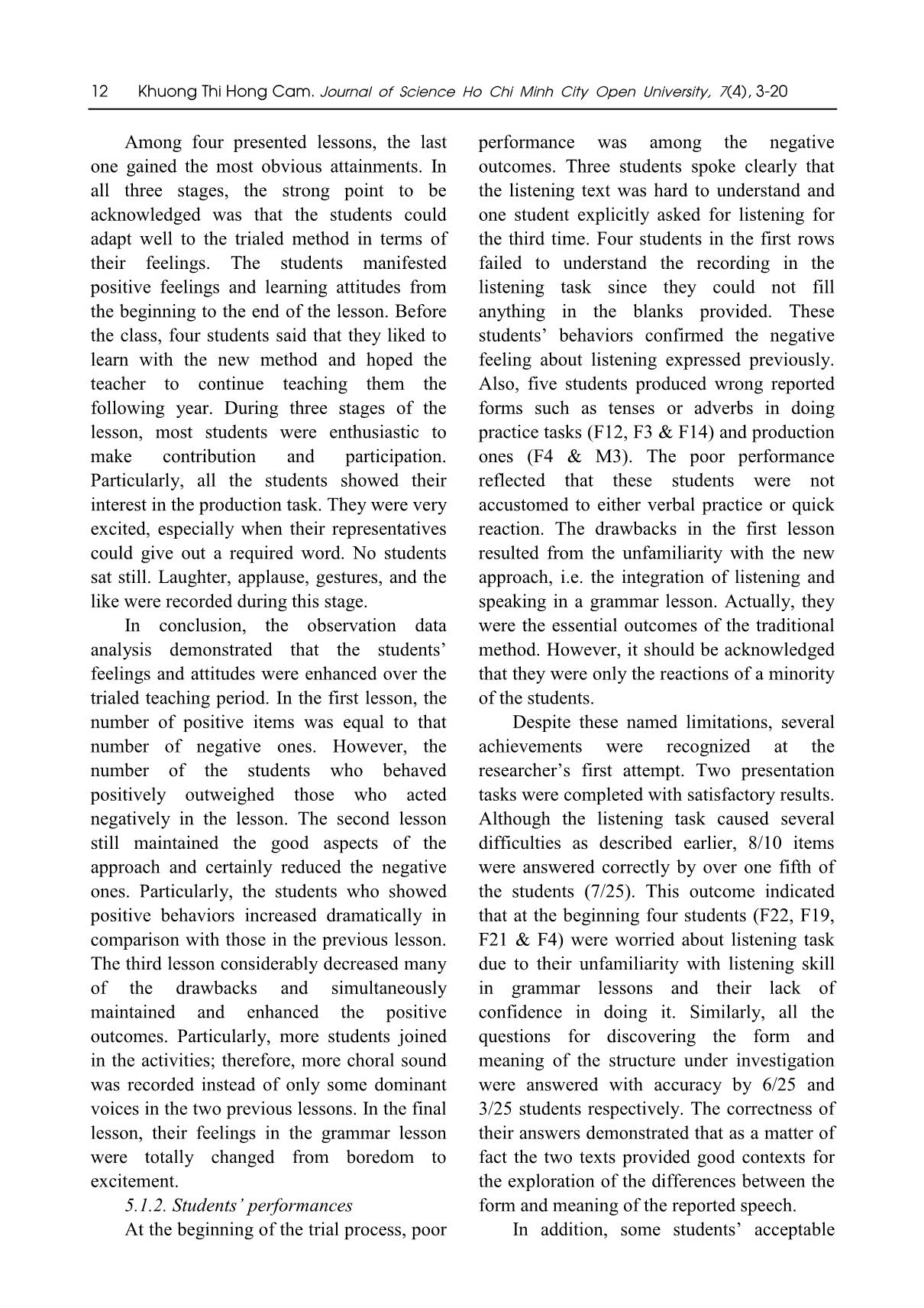
Trang 10
Tải về để xem bản đầy đủ
Tóm tắt nội dung tài liệu: Communicative English grammar teaching to high school learners in Vietnam
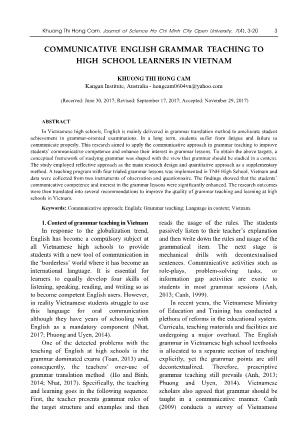
fusion about Khuong Thi Hong Cam. Journal of Science Ho Chi Minh City Open University, 7(4), 3-20 15 forms in the first three lessons, and then improved in the last lesson. The production stage was most innovated with activities that provided students a real purpose to communicate (Harmer, 1991). During this stage, although the students still made mistakes with the forms and showed their passiveness in the first two lessons, they expressed their enjoyment with the activities and grasped the understanding of meaning through all four lessons. In brief, there were two tendencies towards the students’ feelings and performances elicited from the observation data. The greatest of the achievements was the maintenance of the positive attitudes and performances over time. Meanwhile, the drawbacks ranged from reduction to even elimination to the completion of the teaching program. The changes started in the second lesson and gradually became more and more conspicuous from the third to the last one. 5.2. Research question 2: What are the students’ reflections after being taught communicative grammar in terms of lesson content, task design, and feelings? Questionnaires were deployed to help answer the second research question. The data were converted into the three measurements of raw count, percentage and mean. Since this last type of data only serves to triangulate observation data, the trend can be spotted via the calculation of means or central tendencies only. Therefore, the raw counts and percentages are not necessarily scrutinized. The following analysis will investigate the students’ attitudes reflected in the questionnaire data towards the three main themes of lesson content, task design and students’ feelings. 5.2.1. Lesson content The data on lesson content are categorized into the three sub main themes of form, meaning and integration for investigation. For better comparison, the two first sub-themes will be combined for analysis and interpretation (Chart 1). The last one will be addressed for isolated exploration later. Chart 1. Students’ attitudes towards form and meaning 16 Khuong Thi Hong Cam. Journal of Science Ho Chi Minh City Open University, 7(4), 3-20 As a whole, the students showed unfavorable opinions at one end and gradually changed ideas to reverse attitudes towards the other end. Most students disagreed that the form was focused on (M = 3.72) and they were rather unsure that it was well explained (M = 3.12). However, they quite approved that it was well practiced and consolidated (M = 2.2). Most interestingly, they advocated that the form was introduced through context (M = 1.56). Their feedback showed that they actually concentrated on the form although at first it did not seem to be a visible focus. The embedding of context to explore the form as Harmer (1991) proposed was achieved. At the other end of the continuum, all the statements related to meaning were highly backed up by the students since M ranged from 1.56 to 2.0, well below the middle point of 3.0. Most of the students recognized the active role of context in explaining the meaning and use of the structure (M = 1.6). Therefore, in a like manner, they agreed that the meaning and use were well explained (M = 2) and well practiced and consolidated (M = 1.68). Their options convincingly proved that the meaning and use were much emphasized in the conducted lessons, which is in line with the framework of Harmer (1991) and Ur (1996). In the sub-theme of integration (Chart 2), the situation was positive when a majority of the students agreed that four communicative skills were integrated in the grammar lessons (M revolved around 1.36 and 2.52). Chart 2. Students’ attitudes towards integration Specifically, listening, speaking and the combination of these two skills received the most votes, as the means read 1.36, 1.56 and 1.36 respectively. Writing ranked the fourth (M = 2.16) and reading got the lowest support (M = 2.52). Although the reading skill was the least supported by the students, it was remarked as being somewhat integrated. The concern raised by Phuong and Uyen (2014) was solved when both oral and written skills were integrated in the lessons. 5.2.2. Task design The students’ attitudes towards task design in presentation stage and in practice and production stages will be presented. Having a quick look at the means ranging from 1.72 to 2.60 in Chart 3, one can easily figure out that a majority of the students found the tasks in the presentation stage well designed in terms of form, meaning and use thanks to contextualization via listening activities. Khuong Thi Hong Cam. Journal of Science Ho Chi Minh City Open University, 7(4), 3-20 17 Chart 3. Students’ attitudes towards task design in presentation stage Most of the students thought the listening activities were properly designed (M = 1.72). The reason was then given for this proper design: the structure under scrutiny was normally embedded in a context of use. Thus the students agreed that these activities helped introduce the structure naturally (M = 1.84), so they could provide real examples to help use the structure in a proper context (M = 2). In another aspect of this stage, the discovery task, the students highly supported the careful design of the questions about meaning and use (M = 1.96). Satisfactorily, they quite agreed that the questions about form were designed in detail (M = 2.6). Thanks to the attention paid to the three aspects of form, meaning and use at the same, they strongly approved that the questions on the second end of the form-meaning continuum helped them become aware of the use of the structure in a proper context (M = 1.76). According to Chart 4, a majority of the students held the view that the tasks in the practice and production stages were well created (M ranged from 1.68 to 2.84). They agreed that the activities in these stages were various (M = 1.8) to meet different targets of each stage, namely focus on accuracy in practice stage (M = 2.84) and on fluency in production stage (M = 2.32). This variety was implied to encompass all the three main aspects of grammar teaching in both practice and production to achieve communication. Therefore, later on a great number of the students supported the idea that the tasks helped them improve their communicative skills (M = 1.68). Besides, being consistent with their comments earlier on the lesson content, they agreed that the tasks helped them grasp not only the meaning and use (M = 1.88) but also the form (M = 1.84). Since the latter was drilled as well, they had quite optimistic expectations about their performance on normal form-oriented tests (M = 2.12). 1.72 1.84 2 2.6 1.96 1.76 1 1.2 1.4 1.6 1.8 2 2.2 2.4 2.6 2.8 9 10 11 12 13 14 M E A N QUESTIONS Well-designed activities Natural introduction of structure Real examples for proper use of structures Detailed questions about form Detailed questions about meaning and use Helping students become aware of using the structure properly 18 Khuong Thi Hong Cam. Journal of Science Ho Chi Minh City Open University, 7(4), 3-20 Chart 4. Students’ attitudes towards task design in practice and production stages The integration of context into the tasks in three stages (Presentation, Practice and Production) supported by the advocates of function - based grammar theory (Halliday, 1994; McCarthy, 2001) received acknowledgement of the students. Despite focusing on meaning and use, the trial method did reject the importance of form. This finding reinforced the suggestion of Butt et al. (1995). The inclusion of forms also satisfied the grammar-based examinations that Vietnamese education system strongly supported (Toan, 2013). Finally, the finding about students’ communication skills would satisfy those who raised concerns about students’ ability to use English to communicate in their real life (Phuong and Uyen, 2014). 5.2.3. Students’ feelings after the lessons As shown in Chart 5, except for the last item of difficulty (with the mean value of 2.52), the students expressed their feelings in positive emotional terms (M ranged from 1.48 to 2.08). They found the lessons new and strange (M = 1.52). Due to the innovation of the lessons, they felt interested (M = 1.6). Therefore, they became more active to participate in the activities (M = 1.48). With their enthusiastic participation, they asserted that they could absorb the lessons (M = 1.92) and remember the structure well (M = 2.08). These findings were in line with the comments of Ehrenworth and Vinton (2005) and (Ur, 1996) when the grammar points were presented, practiced and produced with the embedding of contexts into tasks. Khuong Thi Hong Cam. Journal of Science Ho Chi Minh City Open University, 7(4), 3-20 19 Chart 5. Students’ feelings after the lessons In brief, the students supported the trialed method with more positive than negative opinions on the content, task design and feelings after the lessons. As far as the content is concerned, except the theme form, the other themes such as meaning and integration highly met their satisfaction. Interestingly, they were satisfied with all the tasks designed in three stages. Finally, with respect to their feelings after four lessons, apart from the complaint about the factor of challenge, they were quite content with the lessons. 6. Conclusion This research was undertaken with a purpose to create a pedagogical reform in English grammar teaching and learning. However, the intervention can only be obtained when there is a unification in both micro and macro levels, which involve high school teachers of English, textbook designers and policy makers who exert authority over the testing system. For high school teachers of English, the teaching program and findings provide teachers of English in Vietnamese high schools with a specification of how to contextualize grammar tasks and how to conduct a grammar lesson in the constraints of their current condition. In preparation for a lesson, teachers can have recourse to communicative course books for authentic contexts in which the communicative purposes of the structure and the specific participants that the language aims at clearly emerge. They should design tasks in presentation, practice and production stages in the way that contextual components are taken into consideration and conduct them in the way that four skills, or at least the two skills of speaking and listening, are integrated. Textbooks designers can relieve a burden from Vietnamese high school teachers if they redesign grammar tasks in English textbooks in a communicative way. To do this, they should consider the elements of meaning and use instead of form only in designing tasks. Instead of providing only mechanical exercises with isolated items, the textbook tasks should be contextualized. However, English textbook writers will still underestimate the importance of communicative aspects until the testing system is given a significant overhaul. Due to the economic and technical constraints in the Vietnamese high school settings, listening and speaking tests will not be able to administered nationwide in the short run. However, the conventional test can be simply modified by contextualizing test items. If students are tested on skills to use the language rather than on a good memory of linguistic rules, testing can provide positive backwash effects on English teaching and learning 20 Khuong Thi Hong Cam. Journal of Science Ho Chi Minh City Open University, 7(4), 3-20 References Anh, D. K. (2013). The current state of the art in the teaching of grammar at Vietnamese high schools. Language in India, 13(3). Barry, A. K. (2002). Linguistic perspectives on language and education. Westport: Greengroup Publishing Group Inc. Butt, D., Fahey, R., Spink, S., & Yallop, C. (1995). Using functional grammar: An explorer guide. Sydney: Macquarie University. Canh, L. V. (1999). Language and Vietnamese Pedagogical Contexts. Retrieved from www.languages.ait.ac.th/Hanoi_proceedings/canh.htm Canh, L. V. (2009). Teaching grammar: a survey of teachers' attitudes in Vietnam. Journal of Asia TEFL, 6(3), 245-273. Chomsky, N. (1968). Language and mind. Cambridge: Cambridge University Press. Cunningham, S., & Moor, P. (2005). New cutting edge. Early-intermediate. Student’s book. Harlow: Longman. Donnelly, C. E. (1994). Linguistics for writers. Albany: University of New York. Ehrenworth, M., & Vinton, V. (2005). The power of grammar: Unconventional approaches to the conventions of language. Portsmouth: Heinemann. Halliday, M. A. (1994). Introduction to functional grammar (2 ed.). London: Edward Arnold. Harmer, J. (1991). The practice of English language teaching. Harlow: Longman. Ho, P. V. P., & Binh, N. T. (2014). The effects of communicative grammar teaching on students’ achievement of grammatical knowledge and oral production. English Language Teaching, 7(6), 74-86. doi:10.5539/elt.v7n6p74 Hutchinson, T. (1996). American hotline: Intermediate - Student’s book. Oxford: Oxford University Press. Lewis, M., & Hill, J. (1992). Practical techniques. London: Commercial Color Press. Littlewood, W. (1981). Communicative language teaching: An introduction. Cambridge: Cambridge University Press. Lock, G. (1996). Functional English grammar: An introduction for second language teachers. Cambridge: Cambridge University Press. McCarthy, M. C. (2001). Issues in applied linguistics. Cambridge: Cambridge University Press. Nhat, M. (2017). English teaching and learning in high schools: Numerous defects and weaknesses. News.zing.vn. Retrieved from post708487.html Paltridge, B. (2006). Discourse analysis: An introduction. New York: Continuum. Phuong, T., & Uyen, T. (2014). Why is the teaching and learning of English "treading water"? Vietnamnet. Retrieved from cho-.html Pollard, A., & Collin, J. (2005). Reflective teaching: Evidence-informed professional practice. New York: Continuum. Sharma, B. D. (2005). Language and linguistics. Dehli: Mehra Offset Press. Toan, V. (2013). English teaching in Vietnam: Teacher ‘re-education’. Tuoi Tre News. Retrieved from Ur, P. (1988). Grammar practice activities: A practical guide for teachers. Cambridge: Cambridge University Press. Ur, P. (1996). A course in language teaching: Practice and theory. Cambridge: Cambridge University Press.
File đính kèm:
 communicative_english_grammar_teaching_to_high_school_learne.pdf
communicative_english_grammar_teaching_to_high_school_learne.pdf

